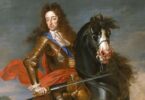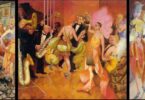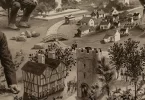Following the collapse and de-population of the Roman Empire from AD 300 – 600, the eleventh, twelfth, and into the thirteenth century saw an acceleration in the growth and development of population in Europe and particularly in China.
From 700 AD rural technologies – using the plough, seed, animal power, wind power, etc. – leapt forward. Classical education of youth in monastery schools increased. These advances were spread particularly rapidly owing to the impetus of Charlemagne and English and Italian allies from 760 to 900 and then again from 1100 to 1250, the period of the Hohenstaufsen Holy Roman Emperors in Germany, Italy and Sicily.
The Dark and Middle Ages
The historian William Manchester described the Dark and Middle Ages as stark in every dimension. Famines and plague, culminating in the Black Death [which killed 1 in 4 people at its peak] and its recurring pandemics, repeatedly thinned the population. . . . Among the lost arts were bricklaying; in all of Germany, England, Holland and Scandinavia, virtually no stone buildings, except cathedrals, were raised for ten centuries. . . . Peasants labored harder, sweated more, and collapsed from exhaustion more often than their animals.
During the Dark Ages, the concept of an economy had little meaning. Human society had reverted to a pre-civilized state, and the primary means of trade was barter. Money all but disappeared from European commerce for centuries. There was, of course, some trade and some lending, but most loans were made with goods, and the interest was charged in goods. These barter-based loans, primitive though they were, enabled people to survive the tough times that were inevitable in an agrarian society.
Yet the church violently opposed even such subsistence-level lending.
https://www.theobjectivestandard.com/issues/2007-fall/morality-of-moneylending/
Please read the ‘Disclaimer and Fair Use‘.







